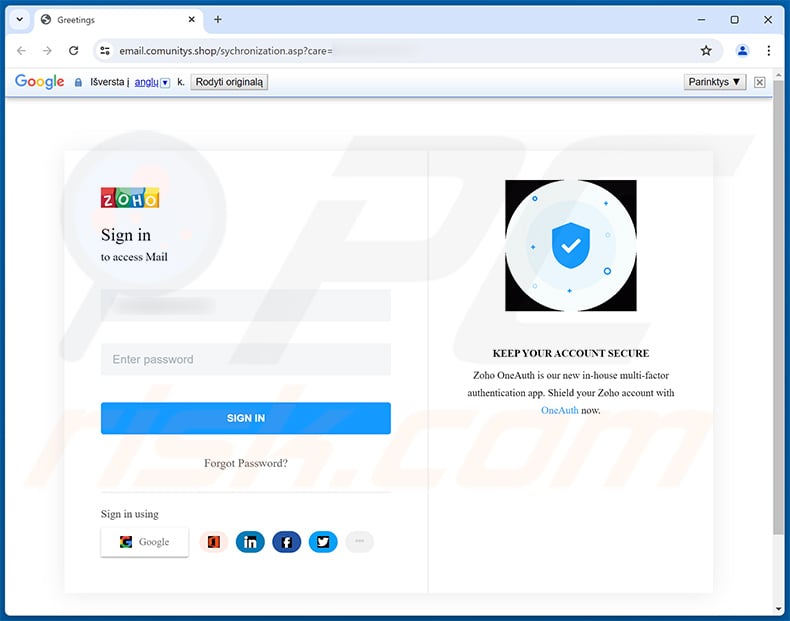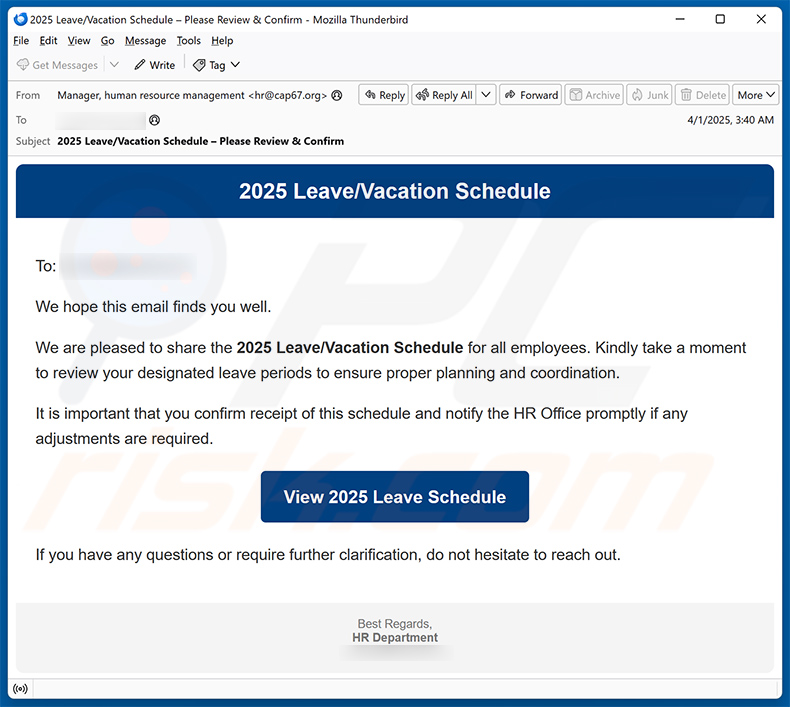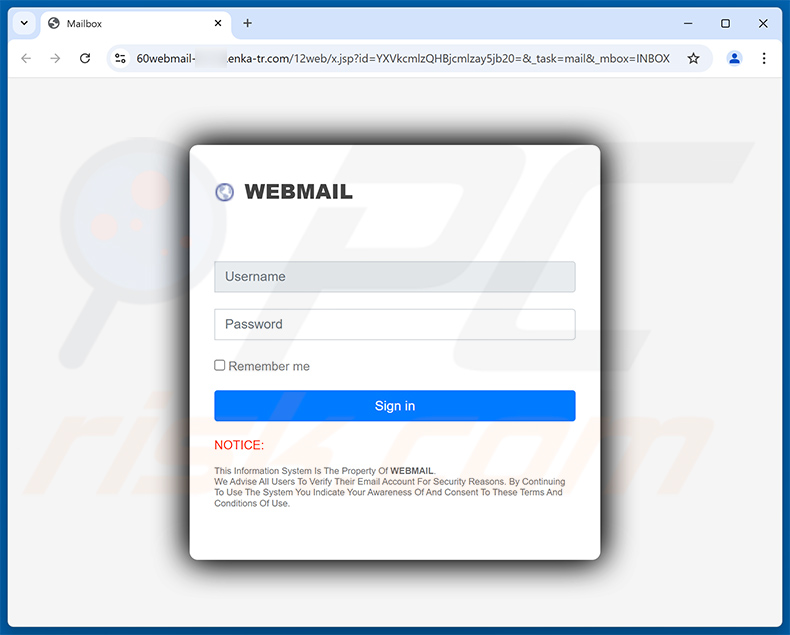Avoid losing your email account via fake "Annual Open Vacation Plan" emails
Phishing/ScamAlso Known As: Annual Open Vacation Plan phishing email
Get free scan and check if your device is infected.
Remove it nowTo use full-featured product, you have to purchase a license for Combo Cleaner. Seven days free trial available. Combo Cleaner is owned and operated by RCS LT, the parent company of PCRisk.com.
What kind of email is "Annual Open Vacation Plan"?
After inspecting the "Annual Open Vacation Plan" email, we learned that it is spam operating as a phishing scam. This letter is presented as a notification regarding vacation approval from an HR (Human Resources) department.
To view the document supposedly containing the list of employees approved for vacation, the recipient is to log-in by using their email credentials. However, this letter and the promoted website are fake; hence, by entering their credentials into the latter - users will expose them to the scammers behind this spam campaign

"Annual Open Vacation Plan" email scam overview
The spam email with the subject "Approval Announcement" (may vary) is presented as a message from the recipient's HR department. The letter claims to contain an attached memo, which lists employee vacation approval statuses.
As mentioned in the introduction, this email is fake. Therefore, when users attempt to view the attachment - they are redirected to a phishing website. The page claims that to access the "Annual Vacation" document - users must sign in with their email account. The log-in credentials (passwords) entered into this page will be recorded and sent to the scammers behind this spam mail.
Cyber criminals target emails because they are typically connected to other platforms, services, etc. (e.g., used to register other content). Hence, through a stolen email - access might be gained to associated content. For example, cyber criminals can use social/communication accounts to ask the contacts for loans or proliferate malware (by sharing malicious files/links) - under the guise of the genuine owner.
The criminals may also make fraudulent transactions or online purchases through hijacked online banking, money transferring, digital wallet, e-commerce, and other finance-related accounts.
In summary, by trusting emails like "Annual Open Vacation Plan" - users can experience serious privacy issues, financial losses, and even identity theft.
If you have already entered log-in credentials into a phishing webpage, we strongly advise changing the passwords of all potentially exposed accounts and contacting their official support without delay.
| Name | Annual Open Vacation Plan phishing email |
| Threat Type | Phishing, Scam, Social Engineering, Fraud |
| Fake Claim | Email contains a memo listing vacation approval statuses |
| Disguise | "HR department" |
| Related Domains | gecaandalucia[.]org |
| Detection Names (gecaandalucia[.]org) | N/A (VirusTotal) |
| Serving IP Address (gecaandalucia[.]org) | 5.135.93.74 |
| Symptoms | Unauthorized online purchases, changed online account passwords, identity theft, illegal access of the computer. |
| Distribution methods | Deceptive emails, rogue online pop-up ads, search engine poisoning techniques, misspelled domains. |
| Damage | Loss of sensitive private information, monetary loss, identity theft. |
| Malware Removal (Windows) |
To eliminate possible malware infections, scan your computer with legitimate antivirus software. Our security researchers recommend using Combo Cleaner. Download Combo CleanerTo use full-featured product, you have to purchase a license for Combo Cleaner. 7 days free trial available. Combo Cleaner is owned and operated by RCS LT, the parent company of PCRisk.com. |
Phishing spam campaign examples
"Your Password Is Set To Expire", "Adobe Reader File email scam", and "Webmail Center email scam" are merely a few examples of phishing emails that we have inspected recently.
Spam is used for a wide variety of scams and even malware distribution. These emails can have various disguises and make likewise varied claims to trick recipients. Due to how widespread this mail is, we strongly recommend exercising caution with incoming emails and messages.
How do spam campaigns infect computers?
Spam emails are commonly used to spread malware. These letters can contain infectious attachments or links leading to malicious websites (i.e., capable of stealthily infiltrating malware or tricking visitors into downloading/installing virulent files).
Malicious files can be in various formats, e.g., executables (.exe, .run, etc.), archives (ZIP, RAR, etc.), Microsoft Office and PDF documents, JavaScript, and so on. Once an infectious file is executed, run, or otherwise opened - the infection process is initiated. For example, Microsoft Office documents cause infections by executing malicious macro commands.
How to avoid installation of malware?
We highly recommend being vigilant with incoming mail. The attachments and links found in suspect/irrelevant emails and messages - must not be opened as that can lead to a system infection. It is important to use post-2010 Microsoft Office versions because they have the "Protected View" mode that prevents automatic macro command execution.
Since malware is not proliferated exclusively via spam mail, we also advise downloading only from official and verified channels. Additionally, all programs must be activated and updated using legitimate functions/tools, as illegal activation tools ("cracks") and fake updaters may contain malware.
We must stress the importance of having a reputable anti-virus installed and updated. This software must be used to run regular system scans and to remove threats. If you've already opened malicious attachments, we recommend running a scan with Combo Cleaner Antivirus for Windows to automatically eliminate infiltrated malware.
Text presented in the "Annual Open Vacation Plan" scam email letter:
Subject: Approval Announcement
Dear All,
Please find below Memo referring to the above subject from approval for your selected annual open vacation plan.
FTPstaffportal/********/ stafffolder/********/announcements/annual-ticket2022/
Please do note that all names highlighted in Red are the ones approved for open vacation.
Termination staff are mark in yellow color indicates staff status to be approved, kindly return your response to verify date onbefore the month end.
Please let me know,should you have further questions.
Human Resources
Announcement
********.
********. – HR supervisor
Human Resource Department
HR supervisor
Message to ******** delivered approval vacation form 29/8/2022 05:010:37
Screenshot of the phishing website promoted by the "Annual Open Vacation Plan" spam campaign:

Examples of other spam emails from "Annual Open Vacation Plan" spam campaign:
Sample 1:

Text presented within:
Subject: Approved Staff Salary Increment / Open Vacation List
Dear **********,
This is important general announcement to all staffs that needs your urgent attention with response.
Kindly open below link for staff memo referring to the above subject matter for our upcoming Open Vacation plan & Staffs Salary Increment.
**********/staff_memo/salary/vacation-information/company/officers
Please note that all names highlighted in Yellow are the ones approved for the upcoming open vacation.
Those marked in Red color indicates staff's whose vacation plan and increment of salary is pending.
Kindly take your time to check carefully before marking the planned date and return your acknowledgement on or before 11/07/2023
Thanks & Regards.
Director of Human Resources
HR Manager
Email:-HR@**********>
Sample 2:

Text presented within:
Subject: RE: Submittal for vacations approval announcement - 2023
Requested by : HR Department
Position : Director of Human ResourcesDear Gentlemen,
Kindly check the Memo:
Just incase you missed my previous announcement or you where unable to view or open the ticket.
Kindly check the stuff memo once again using your correct ******** email credentials to access portal referring to the above subject from HR approval announcement for our annual open vacation plan, along with ******** 2023 terminated empoyees list.-
Please do note that all names highlighted in yellow are the ones approved for open vacation, indicates staff status to be approved.
Termination employees, are mark in yellow color indicates staff status.
Kindly return your response to verify date on before the month end.
Please if you'r unable to view the vacation plan. kindly wait until 24hrs to be able to try again with your correct details.Thanks & Regards,
Director of Human Resources
HR Manager for ********.
112123
Sample 3:

Text presented within:
Subject: ROUTINE LEAVE AND PROMOTION SCHEDULES FOR QUALIFIED STAFF, YOUR ATTENTION IS NEEDED!
ROUTINE LEAVE AND PROMOTION SCHEDULES FOR QUALIFIED STAFF, YOUR ATTENTION IS NEEDED!
Dear
Kindly refer to the below link to find out where your Leave/Vacation schedules for the year 2024 falls and the prerequisite for the same.
You are advised to review the schedules as a matter of urgency and contact the HR Office to indicate your interest, decline or adjustment if there is any need to.
FOR THE SENIOR STAFF, Kindly use the link below to review your schedules:
2024 Leave/Vacation Schedules for Senior Staff .FOR THE JUNIOR STAFF, Kindly use the link below to review your schedules:
2024 Leave/Vacation Schedules for Junior Staff .Best Regards.
HR DIRECTOR
Screenshot of the promoted phishing site:

Sample 4:

Text presented within:
Subject: 2025 Leave/Vacation Schedule – Please Review & Confirm
2025 Leave/Vacation Schedule
To: ********
We hope this email finds you well.
We are pleased to share the 2025 Leave/Vacation Schedule for all employees. Kindly take a moment to review your designated leave periods to ensure proper planning and coordination.
It is important that you confirm receipt of this schedule and notify the HR Office promptly if any adjustments are required.
View 2025 Leave Schedule
If you have any questions or require further clarification, do not hesitate to reach out.
Best Regards,
HR Department
********
Screenshot of the promoted phishing site:

Instant automatic malware removal:
Manual threat removal might be a lengthy and complicated process that requires advanced IT skills. Combo Cleaner is a professional automatic malware removal tool that is recommended to get rid of malware. Download it by clicking the button below:
DOWNLOAD Combo CleanerBy downloading any software listed on this website you agree to our Privacy Policy and Terms of Use. To use full-featured product, you have to purchase a license for Combo Cleaner. 7 days free trial available. Combo Cleaner is owned and operated by RCS LT, the parent company of PCRisk.com.
Quick menu:
- What is Annual Open Vacation Plan phishing email?
- Types of malicious emails.
- How to spot a malicious email?
- What to do if you fell for an email scam?
Types of malicious emails:
![]() Phishing Emails
Phishing Emails
Most commonly, cybercriminals use deceptive emails to trick Internet users into giving away their sensitive private information, for example, login information for various online services, email accounts, or online banking information.
Such attacks are called phishing. In a phishing attack, cybercriminals usually send an email message with some popular service logo (for example, Microsoft, DHL, Amazon, Netflix), create urgency (wrong shipping address, expired password, etc.), and place a link which they hope their potential victims will click on.
After clicking the link presented in such email message, victims are redirected to a fake website that looks identical or extremely similar to the original one. Victims are then asked to enter their password, credit card details, or some other information that gets stolen by cybercriminals.
![]() Emails with Malicious Attachments
Emails with Malicious Attachments
Another popular attack vector is email spam with malicious attachments that infect users' computers with malware. Malicious attachments usually carry trojans that are capable of stealing passwords, banking information, and other sensitive information.
In such attacks, cybercriminals' main goal is to trick their potential victims into opening an infected email attachment. To achieve this goal, email messages usually talk about recently received invoices, faxes, or voice messages.
If a potential victim falls for the lure and opens the attachment, their computers get infected, and cybercriminals can collect a lot of sensitive information.
While it's a more complicated method to steal personal information (spam filters and antivirus programs usually detect such attempts), if successful, cybercriminals can get a much wider array of data and can collect information for a long period of time.
![]() Sextortion Emails
Sextortion Emails
This is a type of phishing. In this case, users receive an email claiming that a cybercriminal could access the webcam of the potential victim and has a video recording of one's masturbation.
To get rid of the video, victims are asked to pay a ransom (usually using Bitcoin or another cryptocurrency). Nevertheless, all of these claims are false - users who receive such emails should ignore and delete them.
How to spot a malicious email?
While cyber criminals try to make their lure emails look trustworthy, here are some things that you should look for when trying to spot a phishing email:
- Check the sender's ("from") email address: Hover your mouse over the "from" address and check if it's legitimate. For example, if you received an email from Microsoft, be sure to check if the email address is @microsoft.com and not something suspicious like @m1crosoft.com, @microsfot.com, @account-security-noreply.com, etc.
- Check for generic greetings: If the greeting in the email is "Dear user", "Dear @youremail.com", "Dear valued customer", this should raise suspiciousness. Most commonly, companies call you by your name. Lack of this information could signal a phishing attempt.
- Check the links in the email: Hover your mouse over the link presented in the email, if the link that appears seems suspicious, don't click it. For example, if you received an email from Microsoft and the link in the email shows that it will go to firebasestorage.googleapis.com/v0... you shouldn't trust it. It's best not to click any links in the emails but to visit the company website that sent you the email in the first place.
- Don't blindly trust email attachments: Most commonly, legitimate companies will ask you to log in to their website and to view any documents there; if you received an email with an attachment, it's a good idea to scan it with an antivirus application. Infected email attachments are a common attack vector used by cybercriminals.
To minimise the risk of opening phishing and malicious emails we recommend using Combo Cleaner Antivirus for Windows.
Example of a spam email:

What to do if you fell for an email scam?
- If you clicked on a link in a phishing email and entered your password - be sure to change your password as soon as possible. Usually, cybercriminals collect stolen credentials and then sell them to other groups that use them for malicious purposes. If you change your password in a timely manner, there's a chance that criminals won't have enough time to do any damage.
- If you entered your credit card information - contact your bank as soon as possible and explain the situation. There's a good chance that you will need to cancel your compromised credit card and get a new one.
- If you see any signs of identity theft - you should immediately contact the Federal Trade Commission. This institution will collect information about your situation and create a personal recovery plan.
- If you opened a malicious attachment - your computer is probably infected, you should scan it with a reputable antivirus application. For this purpose, we recommend using Combo Cleaner Antivirus for Windows.
- Help other Internet users - report phishing emails to Anti-Phishing Working Group, FBI’s Internet Crime Complaint Center, National Fraud Information Center and U.S. Department of Justice.
Frequently Asked Questions (FAQ)
Why did I receive this email?
This mail is not personal. Cyber criminals distributed these emails in large-scale operations with the hopes that at least some of the recipients will fall for their scams.
I have provided my personal information when tricked by this spam email, what should I do?
If you have disclosed log-in credentials - immediately change the passwords of all possibly compromised accounts and inform their official support. And if you've provided other private information (e.g., ID card details, credit card numbers, etc.) - contact the corresponding authorities without delay.
I have read a spam email but didn't open the attachment, is my computer infected?
No, opening/reading a spam email will not result in a system infection. Malware is proliferated via attachments and links in this mail; hence, infection processes are triggered when said files or links are opened/clicked.
I have downloaded and opened a file attached to a spam email, is my computer infected?
If it was an executable (.exe, .run, etc.) - most likely, yes. When opened, these formats infect systems almost without fail. Documents (.doc, .xls, pdf), on the other hand, may require additional user interaction (e.g., enabling macro commands) to begin downloading/installing malware.
Will Combo Cleaner remove malware infections present in email attachments?
Yes, Combo Cleaner is designed to detect and remove threats. It can eliminate practically all known malware infections. Note that since high-end malicious software usually hides deep within systems - performing a full system scan is essential for its detection.
Share:

Tomas Meskauskas
Expert security researcher, professional malware analyst
I am passionate about computer security and technology. I have an experience of over 10 years working in various companies related to computer technical issue solving and Internet security. I have been working as an author and editor for pcrisk.com since 2010. Follow me on Twitter and LinkedIn to stay informed about the latest online security threats.
PCrisk security portal is brought by a company RCS LT.
Joined forces of security researchers help educate computer users about the latest online security threats. More information about the company RCS LT.
Our malware removal guides are free. However, if you want to support us you can send us a donation.
DonatePCrisk security portal is brought by a company RCS LT.
Joined forces of security researchers help educate computer users about the latest online security threats. More information about the company RCS LT.
Our malware removal guides are free. However, if you want to support us you can send us a donation.
Donate
▼ Show Discussion